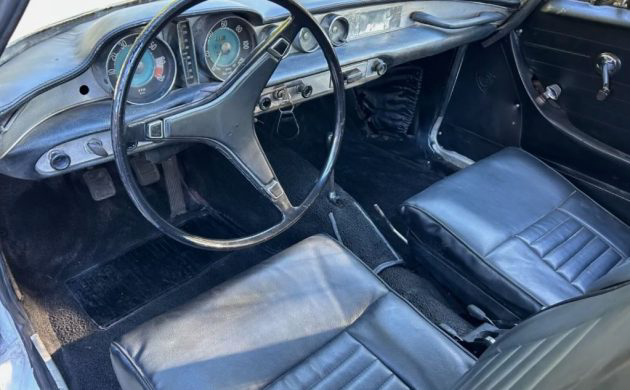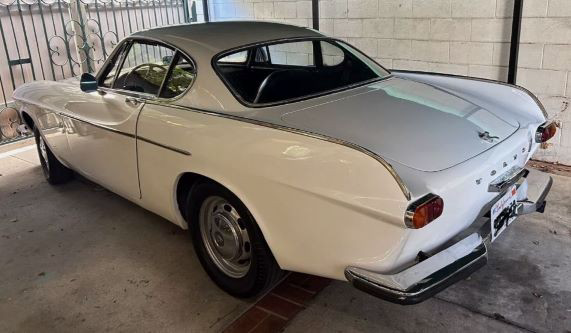In the 1950s, Volvo’s US-sold vehicles included two stodgy but rally-worthy dumplings: the PV444/544 and the Amazon 120 series. Neither car lit the pavement on fire, but both sold reasonably well. Meanwhile, American producers were refining the likes of the Corvette and the Thunderbird – each exponentially more rakish than Volvo’s offerings. To round out its repertoire, Volvo set its sights on the sports car niche. Stung by the poor reception generated by its first attempt – the fiberglass P1900 – the company returned in 1959 with a more worthy competitor – the P1800. Designed by Swede Pelle Petterson while he was working for Pietro Frua in Italy, and constructed by England’s Jensen Motors, the car’s cosmopolitan bona fides worked magic during the pre-production show-off period starting in 1959. After substantial teasing, the car was finally ready to launch into an eager market, but quality problems at Jensen provoked a switch to Swedish factories in 1963. The car’s exotic looks have only gathered more fans as the years roll by, causing a surge in prices. Here on eBay is a very nice 1968 Volvo 1800S coupe with an asking price of $22,500 or best offer. The car is located in Los Angeles, California.
The 1.8 liter, dual-carburetor, four-cylinder B18 engine made about 115 hp by 1968. The M40 four-speed transmission had synchromesh in all four gears (overdrive was optional). What this combination gave up in performance (the ’68 took over 12 seconds to reach 60 mph, and managed a top speed of just over 100 mph), it accrued in reliability. Volvo – always handy with a tongue-in-cheek marketing tactic – called the car “either the prettiest truck ever made or the world’s most reliable sports car”. Irv Gordon, who passed away about six years ago, accumulated 3.2 million miles on his cherry red 1800. Today’s car has 54,900 miles on the odometer (TMU); a Weber has replaced its SU carbs. The car runs and drives well.
Inside, the upholstery, carpets, dash, gauges, trim, and glass are mostly spiffy. The driver’s seat is modestly worn, but completely tolerable. By 1968, safety regulations were just beginning to roil the industry – that padded, three-spoke steering wheel was new. The rear seats are in fine shape – as usual! The underside is dry, though undercoating obscures the view.
The paint is said to be nearly blemish-free, with nary a scratch or dent anywhere. As mentioned, prices have been climbing for this pretty Swede, with exceptional cars trading for over $50k. Still, all is not lost: a less-than-perfect early example might sell for $20k. Our subject car’s condition seems to warrant the asking price; what do you think?









Another P1800 (don’t go there, read my posts in other 1800S’s) to temp me. I’m sadly a Volvo tragic, and a Ford lover. There’s room for both, lol.
Combine your passions with a 302 and a T5 trans in one
It looks REALLY nice, and I’d rather spend that price on this than anything I see on the road today. I would want OD, but it’s probably not impossible to add it if it’s missing, no?
It has overdrive! It is also easy to add to 4 speed cars and not terribly hard if it has a (yuck) Borg Warner 3 speed.
Ditch the downdraft Weber for DCOEs or SUs.
Looks to be a pretty good car for $20k.
Nice car. Would get it’s horse power back to factory specs if the twin carbs were put back on. Spent some time on the track with an 1800 ES and it didn’t take all that much to make it a consistent winner. Good looking design and great road cars.
Really nice car.
I had a B18 122S, and an entire fraternity could not kill that car.
SU carbs are very simple. I don’t know why people rush to replace them when a problem arises. Other than the Weber I really like this car.
Sus are quirky for sure- the only carb I know that you have to check the oil level in. And some folks have trouble getting multiple carbs to play nice together. I like them even if I can’t get them to idle in the same place twice
Pipsisewah: to tune SUs you get a Unisyn gadget that allows you to look at a red plastic marker that floats in the air while hooked up to each carb. Once the red indicator is at the same height on each carb (once your screwdriver has done the required adjusting), your carbs are in synch. An even cheaper way to synchronise your carburettors is to put a rubber pipe up to each carb with its air cleaner removed. You then use your screwdriver to do the adjusting of the screws, until the sound of the hiss in each carb is the same. I don’t know why Americans are so SU-phobic. Probably because they are not fou- barrel American carbs…but they are SO SIMPLE! One can rebuild them with one’s eyes closed! They are SO BASIC because they were patented in 1922…one hundred and two years ago!
And that process is completely pointless if the throttle shafts are worn out.
5-6 years ago, I got a used weber with Canon manifold for less than the cost of the basic rebuild kit for twin SUs.
I could have sent the carbs out to Curto or Apple, and they would have been perfect. And it would only cost 4 times as much as the Weber.
I’ve run both, as well as the Z-S.
It’s not a big deal but that wheel in the box – which presumably is the spare, appears to be different to those on the car. The one in the box is a different pattern and appears to be alloy.
Really nice car however.
Great write up for a great car. Very complete with stuff I didn’t know. This is why I read BF every day and pass over 100 other emails.
Very nice Volvo 1800S